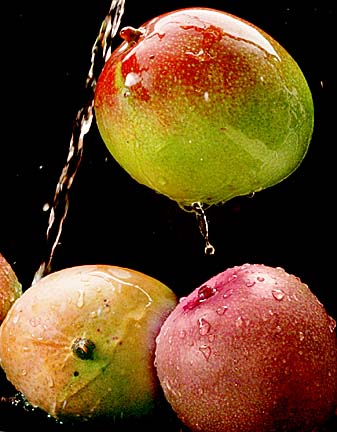

Key Ingredient

|
It's the peak of mango season and there's plenty to go around. Nothing welcomes summer like the taste of a sweet and juicy mango. MANGOES
The basics: The mango tree is an evergreen, believed to originate in the Indo-Burma region. It is the single most important fruit in India and is believed to be sacred by East Indians, who have consumed mangoes for centuries. Today about 1,000 varieties of mango are grown and cultivated in temperate climates throughout the world.
Mangoes arrived on Hawaii shores sometime in the early 1800s. The fruit comes in many shapes, from oblong to round, and sizes from 5 or 6 ounces to several pounds. The flesh can range from bright yellow to deep orange when ripe. Green mango is also popular here and throughout Asia as an ingredient in relishes, chutneys and pickles. Popular varieties locally include Hayden, Pirie, Mapulehu, Momi K and Ataulfo.
Tommy Atkins is a popular mainland variety gaining popularity here, too. Grown mainly in California, Florida and Mexico, the variety is firmer in texture and is not as juicy and flavorful as Hawaii mangoes.
Mangoes are a good source of vitamin A, C and fiber and can act as a tenderizing agent due to the presence of particular enzymes.
Selecting: For ripe mangoes look for fruit with a glossy red or orange tinge. The mango should be firm, but give a little when pressed. A few black spots are natural for ripening mangoes, but avoid soft and bruised fruit -- clear signs that the fruit is overripe. Larger fruit have a higher fruit-to-seed ratio. For green mangoes, the Chinese or common variety is recommended and should be firm and totally green.
Storing: Unripe mangoes should be stored at room temperature to ripen. Ripe mangoes may be refrigerated for up to a week.
Use: Mangoes in peak season should be enjoyed simply peeled and eaten as is. There is no substitute for fresh, juicy mangoes. They can also be diced and added to salads and tropical fruit sauces or made into refreshing smoothies. Overripe mangoes can be used to make tasty treats such as mango bread or sorbet. Now is also the time to whip up pickled mango and chutney.
Where to buy: Mangoes should be abundant through September at supermarkets and farmers markets and in Chinatown. Prices range from $1.59 to $2.79 a pound.
Food Stuffs: Morsels
Eleanor Nakama-Mitsunaga is
a free-lance food writer. Contact her
online through features@starbulletin.com